Omron Compressor Nebulizer NE-C101 Instruction Manual
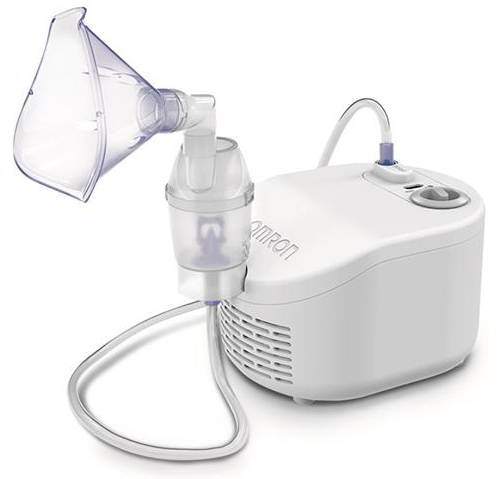
Content
Omron Compressor Nebulizer NE-C101 Introduction
This product was developed in conjunction with respiratory therapists for the successful treatment of asthma, chronic bronchitis, allergies, and other respiratory disorders. This is a medical device. Operate the device only as instructed by your doctor and/or respiratory therapist. With its user-friendly design, the NE-C101 ensures a hassle-free experience at home. The exact cost of the Omron NE-C101 is $75.00.
Optional Medical Accessories
(within the scope of EC Medical Device Directive 93/42/EEC)
Product description | Model |
Nebulizer Kit | NEB-NK-11AP |
Nebulizer Kit & Adult Mask & Air Tube Set | NEB-NSET4-11AP |
Nebulizer Kit & Child Mask & Air Tube Set | NEB-NSET5-11AP |
Adult Mask (PVC) | NEB-MSLP-AP |
Child Mask (PVC) | NEB-MSMP-AP |
Mouthpiece | NEB-MP-AP |
Nosepiece | NEB-NP-AP |
Air Tube (PVC, 100cm) | NEB-TP-L10AP |
Other Optional/Replacement Parts
Product description | Model |
Air Filters x 5 | NEB-AFR-30AP |
How the nebulizer kit works
The medication that is pumped up through the medication channel is mixed with compressed air which is generated by a compressor pump. The compressed air mixed with medication is turned into fine particles and sprayed when in contact with the baffle.
Intended use
Medical Purpose
This product is intended to be used for inhaling medication for respiratory disorders.
Intended User
- Legally certified medical experts, such as doctors, nurses, and therapists.
- Caregiver or patient under the guidance of qualified medical experts for home treatment.
- The user should also be capable of understanding the general operation of NE-C101 and the content of the instruction manual.
Intended Patients
This product should not be used on patients, who are unconscious or are not breathing spontaneously.
Environment
This product is intended for use in a medical facility, such as a Hospital, clinic, or doctor’s office, and in a room of the general household.
Durable period
Durable periods are as follows, provided the product is used to nebulize saline 3 times a day for 10 minutes each time at room temperature (23°C). The durable period may vary depending on the usage environment. Frequent use of the product may shorten the durability period.
- Compressor (Main unit) 5 years
- Nebulizer Kit 1 year
- Mouthpiece 1 year
- Nosepiece 1 year
- Air Tube (PVC) 1 year
- Air Filter 60 days
- Mask (PVC) 1 year
Precautions for use
Warnings and cautions described in the instruction manual should be observed.
Know your unit

Technical data
- Product Category: Nebulizers
- Product Description: Compressor Nebulizer
- Model: NE-C101
- Rating: 230V 50Hz
- Power Consumption: 150VA
- Current Fuse: T1.6AL250V
- Operating Mode: Continuous Use
- Operating Temperature/ Humidity/Air Pressure: +5°C to +40°C / 15% to 85%RH (non-condensing) 700 to 1060hPa
- Storage and Transport
- Temperature/Humidity: -20°C to +60°C / 5% to 95%RH (non-condensing)
- Weight: Approx. 1.05kg (compressor only)
- Dimensions: Approx. 145 (W) × 124 (H) ×182 (D) mm (compressor only)
- Contents: Compressor, Nebulizer Kit, Air Tube (PVC, 100cm), Mouthpiece, Nosepiece, Adult Mask (PVC), Child Mask (PVC), 2 pcs Spare Air Filters, Instruction Manual, Quick Start Guide.
- Classification: Class ll (Protection against electric shock), Type BF (Applied part); Mouthpiece, Nosepiece, Mask IP21 (Ingress Protection)
Technical data for the NE-C101 Compressor:
- Particle Size: **MMAD Approx. 3.90μm MMAD = Mass Median Aerodynamic Diameter
- Medication Tank Capacity: 12ml maximum
- Appropriate Medication Quantities: 2ml minimum - 12ml maximum
Noise level (at 1m distance): *Less than 63dB - Nebulization Rate: *Approx. 0.3ml/min (by weight loss)
- Aerosol Output: 0.259ml (2ml, 1%NaF)
- Aerosol Output Rate: 0.05ml/min (2ml, 1%NaF)
Result of cascade impactor measurements for particle size**
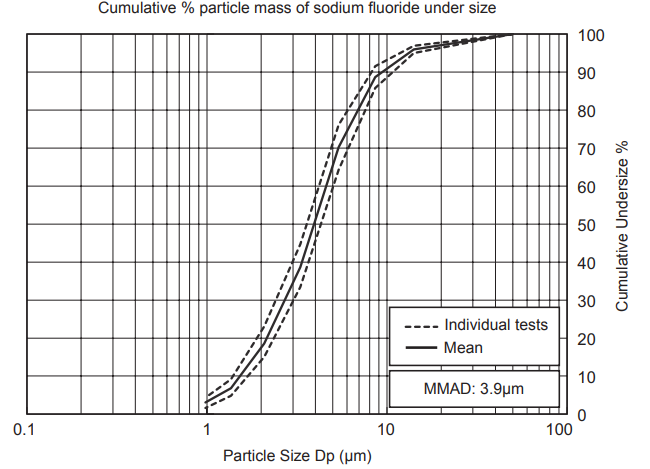
- Measured by OMRON HEALTHCARE Co., Ltd.
- Measured values reflect internal data obtained by NEXT GENERATION IMPACTOR (NGI), according to EN13544-1:2007 + A1:2009 and ISO27427:2013.
Notes
- Subject to technical modification without prior notice.
- This OMRON product is produced under the strict quality system of OMRON HEALTHCARE Co., Ltd., Japan.
- The device may not work if the temperature and voltage conditions are different to those defined in the specifications.
- Ensure that this device has acclimated to room temperature before nebulizing the medication. Nebulizing the medication after an extreme temperature change could lead to less nebulization. OMRON recommends waiting for approximately 2 hours for the device to warm up or cool down when the device is used at an environment within the temperature specified as operating conditions after it is stored either at the maximum or at the minimum storage temperature. For additional information of operating and storage/transport temperature, refer to Technical data
- The device fulfills the provisions of the EC directive 93/42/EEC (Medical Device Directive) and the European Standard EN13544-1:2007+A1:2009, Respiratory therapy equipment - Part1: Nebulizing systems and their components.
- Performance may vary with medication such as suspensions or high viscosity. See the medication supplier’s data sheet for further details.
- IP classification is degree of protection provided by enclosures in accordance with IEC 60529. The device is protected against solid foreign objects of 12.5mm diameter and greater such as finger and against vertically falling water drops which may cause issues during a normal operation.
Symbols Description
 | Need for the user to consult the instructions for use |
 | Applied part - Type BF Degree of protection against electric shock (leakage current) |
Class ll Protection against electric shock | |
| Ingress protection degree provided by IEC 60529 |
 | CE Marking |
 | Serial number |
Temperature limitation | |
 | Humidity limitation |
 | Atmospheric pressure limitation |
Power OFF | |
Power ON | |
Alternating current |
Product production date is integrated in the Serial number, which placed on the product and/or sales package: the first 4 digits mean year of production, the next 2 digits mean month of production.
Description
The Omron Compressor Nebulizer NE-C101 is engineered with patient comfort and convenience in mind. The device features a simple and intuitive interface, making it easy to operate even for those with limited technical experience. The nebulizer chamber is designed for easy filling and cleaning, reducing the risk of contamination and ensuring optimal performance. The included accessories such as the mask and mouthpiece are designed to fit comfortably, ensuring that patients can breathe easily while receiving their medication.
The NE-C101 also comes with a washable filter to maintain the quality of the air being inhaled, adding an extra layer of safety and hygiene. The device's compact size and lightweight design make it portable, allowing patients to receive treatment anywhere.
How to use Omron Compressor Nebulizer NE-C101
Warning: Clean and disinfect the nebulizer kit, mask, mouthpiece or nosepiece before using them when as follows:
- the first time after purchase
- if the device has not been used for a long period of time
- if more than one person uses the same device
For the instructions, refer to the “Cleaning and disinfecting” section.
- Make sure that the power switch is in the off (
 ) position.
) position. - Plug the power plug into a power outlet.
Note: Do not place the device in a location where it is difficult to disconnect the power cord. - Remove the inhalation top from the medication tank.
- Rotate the inhalation top anti-clockwise.
Lift the inhalation top out of the medication tank.
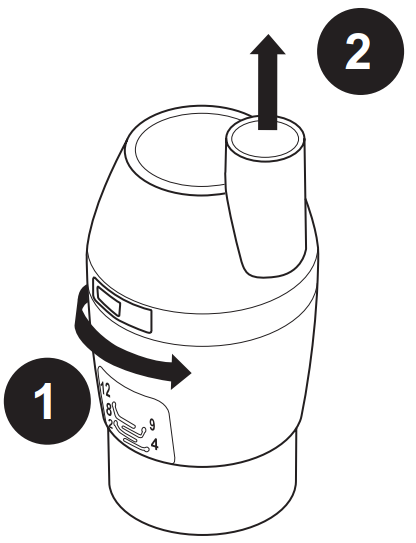
Add the correct amount of prescribed medication to the medication tank.
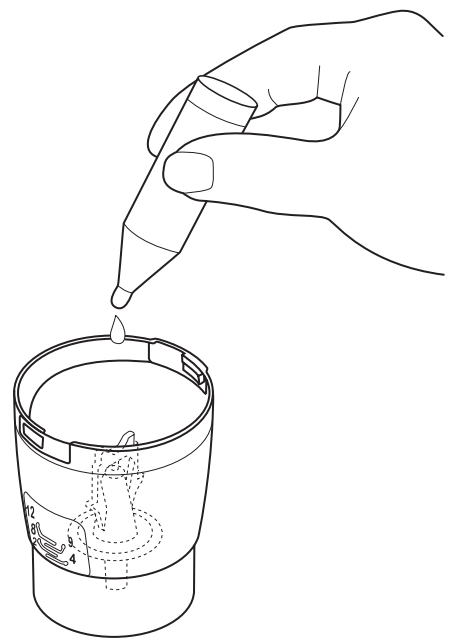
- Make sure that the vaporizer head is placed in the medication tank.
- Put the inhalation top back onto the medication tank.
- Lower the inhalation top on the medication tank.
Rotate the inhalation top clockwise.
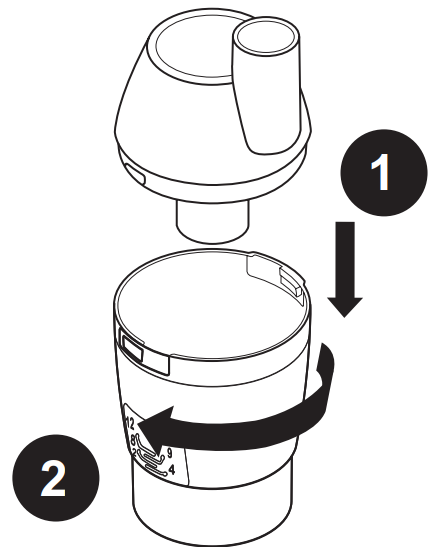
Attach the mask, mouthpiece or nosepiece to the nebulizer kit tightly.
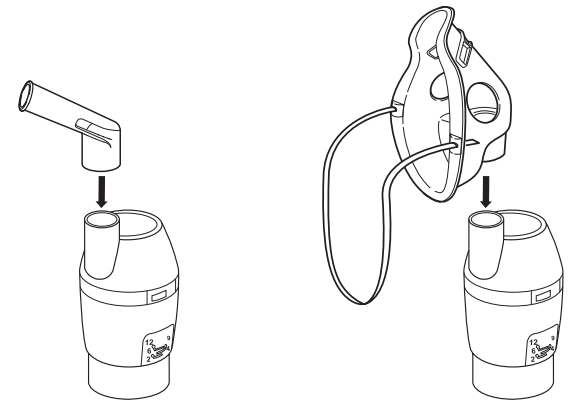
Attach the air tube. Twist the air tube plug slightly and push it firmly into the air tube connector.
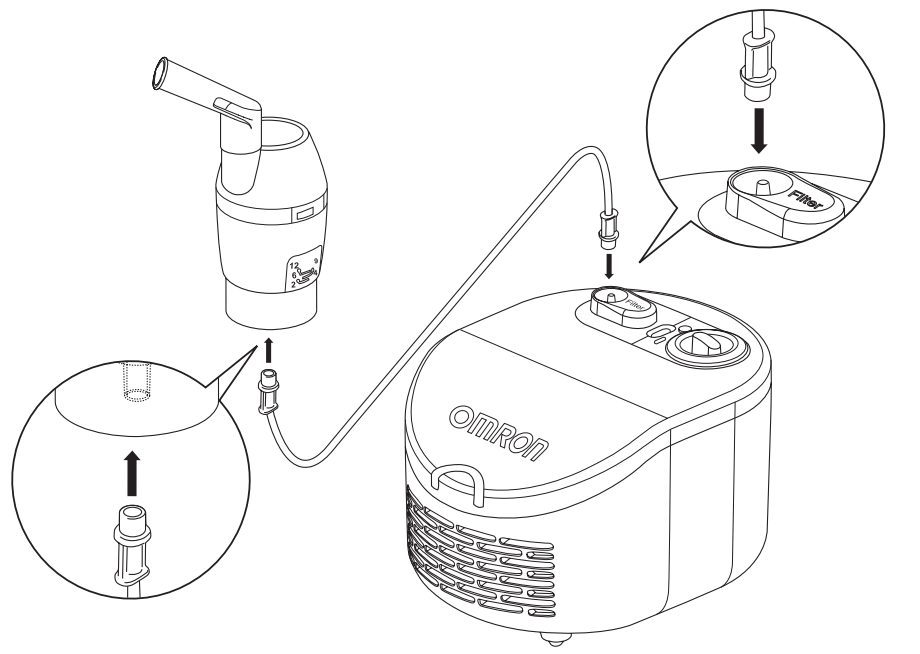
Hold the nebulizer kit as indicated below.
Follow the instructions of your doctor or respiratory therapist.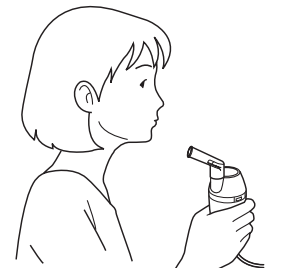
Caution: Do not tilt the nebulizer kit at an angle of greater than 30 degrees in all directions. Medication may flow into the mouth or it may result in not nebulizing effectively.
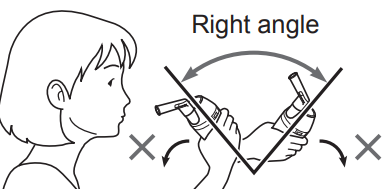
- Turn the power switch to the on (
 ) position. As the compressor starts, nebulization begins and aerosol is generated. Inhale the medication.
) position. As the compressor starts, nebulization begins and aerosol is generated. Inhale the medication. - When treatment is complete, turn the power off and unplug the compressor from the power outlet.
Cleaning and disinfecting
Caution: Handling the Vaporizer Head
- Always wash the vaporizer head after each use.
- Do not use a brush or pin to clean the vaporizer head.
- When disinfecting the parts by boiling, be sure to boil them in plenty of water.
- Do not boil the vaporizer head together with objects other than applicable nebulizer accessories.
Cleaning
Clean the parts after each use to remove residual medication. This will avoid inefficient nebulization or infection.
Washable parts
- Nebulizer Kit, Mask (PVC), Mouthpiece, Nosepiece
Wash them in warm water and mild detergent (neutral detergent). Rinse them thoroughly with clean hot tap water and allow to air dry in a clean place. - Vaporizer Head
Wash it with running water.
Non-washable parts
- Compressor, Air Tube (PVC)
Firstly, make sure that the power plug is unplugged from the power outlet. Wipe clean with a soft cloth moistened with water or mild detergent (neutral detergent). - Air Filter
Do not wash or clean the air filter. If the air filter becomes wet, replace it. Damp air filters can cause blockages.
Disinfecting
- Disinfect the parts once a week. If the parts are heavily stained, replace them with new ones.
- To select a method for disinfection, refer to the table below.
o: applicable X: not applicable
Disinfecting method |
Parts |
Mouthpiece |
Nosepiece |
Nebulizer Kit |
Adult Mask (PVC) Child Mask (PVC) |
Air Tube (PVC, 100cm) |
Air Filter |
Materials |
PP |
PP |
PP |
Mask: PVC (Phthalate free) Band: Rubber*** |
PVC (Phthalate free) |
Polyester | |
A | Alcohol | o | o | o | o** |
X |
X |
Disinfecting ethanol | |||||||
Sodium hypochlorite
|
o |
o |
o |
o** |
X |
X | |
Milton* (0.1%, 15min.) | |||||||
Quaternary ammonium
|
o |
o |
o |
o** |
X |
X | |
Osvan* (0.1%, 10min.) | |||||||
Chlorhexidine | o | o | o | o** |
X |
X | |
Hibitane* (0.5%, 30min.) | |||||||
Amphoteric Surfactant
|
o |
o |
o |
o** |
X |
X | |
Tego 51* (0.2%, 15min.) | |||||||
B | Boiling | o | o | o | X | X | X |
- An example of commercially available disinfectant. (The concentration and residence time specified in the table are under the conditions where the service life of the parts is tested with each disinfectant used as described in its instruction manual. Please note that the testing was not performed for the purpose of ensuring the effectiveness of the disinfectants. There is no intention of suggesting that such disinfectants be used. Conditions of use and ingredients of disinfectant vary for manufacturers. Please read the instruction manuals carefully before use and apply disinfectant to each part in an appropriate way. Please notice that service life of the parts may be shorter depending on conditions, environments and frequency of use.)
- Remove the rubber band from mask before disinfecting.
- The band not made with natural rubber-latex.
A. Use a commercially available disinfectant. Follow the instructions provided by the disinfectant manufacturer.
Note: Never clean with benzene, thinner or a flammable chemical.
B. Parts may be boiled between 15 to 20 minutes. After boiling, carefully remove the parts, shake off excess water and allow to air dry in a clean environment.

Removing condensation from the air tube
If there is moisture or liquid remaining in the air tube, be sure to follow the procedure below to remove any moisture from within the air tube.
- Make sure that the air tube is connected to the air connector on the compressor.
- Remove the air tube from the nebulizer kit.
- Turn on the compressor and pump air through the air tube to expel the moisture.
Changing the air filter
If the air filter has been used for more than 60 days, replace it with a new one.
Remove the air filter cover using a flat screwdriver as shown on the right.
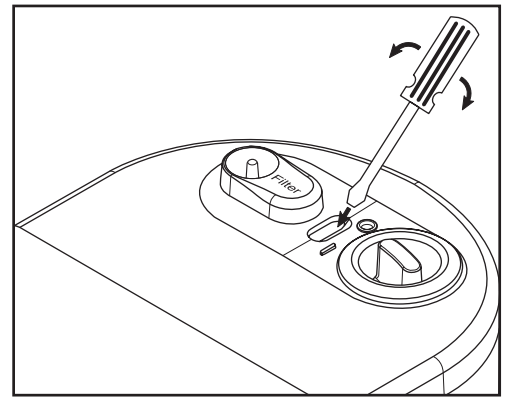
- Change the air filter.
Remove the old air filter and insert the new air filter. Put the air filter cover back in place.
Make sure it is attached properly.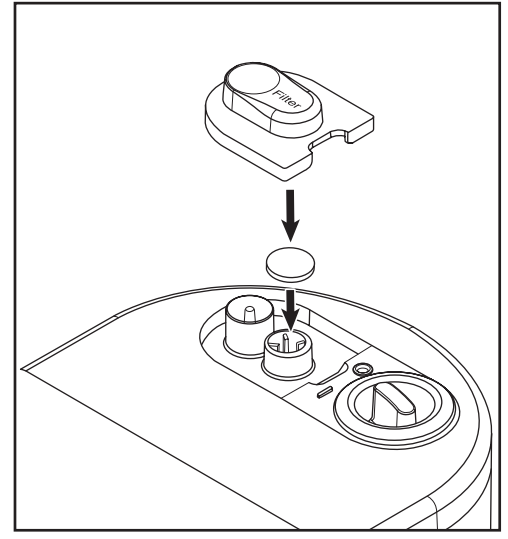
Notes
- Use only OMRON air filters designed for this device. Do not operate without a filter.
- Do not wash or clean the filter. If the air filter becomes wet, replace it. Damp air filters can cause blockages.
- There is no front or back orientation for the air filters.
- Check that air filters are clean and free of dust before inserting them.
Setup Guide
To operate the Omron Compressor Nebulizer NE-C101, follow these steps:
- Unpack the device and all included accessories.
- Wash your hands thoroughly before handling the nebulizer parts.
- Fill the nebulizer chamber with the prescribed medication. Ensure not to exceed the maximum fill line.
- Connect the nebulizer chamber to the compressor using the provided tubing.
- Attach the mask or mouthpiece to the nebulizer chamber.
- Plug in the compressor and turn it on. The device will start producing a fine mist that you can inhale through the mask or mouthpiece.
- Continue treatment until the medication is fully nebulized, usually indicated by a decrease in mist output.
- After treatment, turn off the compressor and disconnect it from the power source.
- Clean and disinfect all reusable parts according to the manufacturer's instructions.
Important safety instructions
Read all the information in the instruction manual and any other literature included in the box before using the device.
Warning: Indicates a potentially hazardous situation which, if not avoided, could result in serious injury.
(Usage)
- For type, dose, and regime of medication follow the instructions of your doctor or respiratory therapist.
- If you experience any allergic reactions or other difficulties during use, stop using the device immediately and consult your doctor.
- Do not use only water in the nebulizer for inhaling purposes.
- Keep the device out of reach of unsupervised infants and children. The device may contain small pieces that can be swallowed.
- Do not store the air tube while there is moisture or medication remaining inside.
- Do not use or store the device where it may be exposed to noxious fumes or volatile substances.
- Do not use the device where it may be exposed to flammable gas.
- Do not cover the compressor with a blanket, towel, or any other type of cover during use. The compressor could get hot and there is a possible risk of a burn if touched.
- Always dispose of any remaining medication after use, and use fresh medication each time.
- Do not use in anaesthetic or ventilator breathing circuits.
- Do not block the ventilation slots. Never place the device where the ventilation slots may be obstructed during operation. The compressor could get hot and there is a possible risk of a burn if touched.
- Store the parts in a clean location to avoid infection.
(Risk of electrical shock)
- Never plug or unplug the device with wet hands.
- The compressor and power cord are not waterproof. Do not spill water or other liquids on these parts. If liquid does spill on these parts, immediately unplug the power cord and wipe off the liquid with gauze or other absorbent material.
- Do not immerse the compressor in water or other liquid.
- Do not use or store the device in humid locations.
- Do not operate the device with a damaged power cord or plug.
- Keep the power cord away from heated surfaces.
Cleaning and disinfecting
Observe the rules below when cleaning or disinfecting parts. Failure to observe these rules may result in damage, inefficient nebulization or infection. For the instructions, refer to “Cleaning and disinfecting” section.
- Clean and disinfect the nebulizer kit, mask, mouthpiece or nosepiece before using them when as follows:
- the first time after purchase
- if the device has not been used for a long period of time
- if more than one person uses the same device
- Be sure to wash or wipe the parts after use, and ensure that they are thoroughly disinfected and dried, and stored in a clean location.
- Do not leave the cleaning solution to dry on the parts.
Caution: Indicates a potentially hazardous situation which if not avoided, may result in minor or moderate injury, or physical damage.
(Usage)
- In order to prevent strangulation by the power cord or air tube, or injuries caused by mishandling, please provide close supervision when this device is being used by, on or near children or invalids.
- Make sure that the parts are attached correctly.
- Make sure that the air filter is correctly attached.
- Make sure that the air filter is clean. If the air filter has been used for more than 60 days, replace it with a new one.
- Do not tilt the nebulizer kit at an angle of greater than 30 degrees in all directions or shake it while in use.
- Do not use or store the device while the air tube is creased.
- Use only original nebulizing parts, air tube, air filter and air filter cover.
- Do not add more than 12 ml of medication to the medication tank.
- Do not carry or leave the nebulizer kit while the medication tank contains medication.
- Do not leave the device unattended with infants or persons who cannot express their consent.
- Do not subject the device to any strong shocks such as dropping on the floor.
- Do not distort the vaporizer head, or jab the nozzle of the medication tank with a pin or any sharp object.
- Do not insert fingers or objects inside the compressor.
- Do not disassemble or attempt to repair the compressor or power cord.
- Do not leave the device in extreme hot or cold temperature, or under direct sunlight.
- Do not block the air filter cover.
- Do not use the device while sleeping or if drowsy.
- Approved for human use only.
- The compressor may become hot during operation.
- Do not touch the compressor for other than necessary operation such as turning off the power while nebulizing.
- To avoid the medication residue on the face, be sure to wipe the face after removing the mask
- To avoid injury to the nose mucosa, do not squeeze the nosepiece into the back of the nose.
- Do not block the slit between the cap and the inhalation air inlet.
- Make sure that the vaporizer head is correctly installed before use.
- Do not use a damaged nebulizer kit, mouthpiece or nosepiece.
- While using this device, make sure that no mobile phone or any other electrical devices that emit electromagnetic fields is within 30cm. This may result in degradation of performance of the device.
(Risk of electrical shock)
- Always unplug the device from the power outlet after use and before cleaning.
- Plug the device into the appropriate voltage outlet. Do not overload power outlets or use extension cords.
- Do not misuse the power cord.
- Do not wind the power cord around the compressor.
- Changes or modifications not approved by OMRON HEALTHCARE will void the user warranty.
- Do not pull the power cord strongly. (Cleaning and disinfecting) Observe the rules below when cleaning or disinfecting parts. Failure to observe these rules may result in damage, inefficient nebulization or infection. For the instructions, refer to “Cleaning and disinfecting” section.
- Do not use a microwave oven, dish dryer or hair dryer to dry the device or the parts.
- Do not use an autoclave, EOG gas sterilizer or low-temperature plasma sterilizer.
- When disinfecting parts by boiling, make sure that the container does not boil dry. Otherwise, it may also result in a fire.
General Safety Precautions:
- Inspect the device and parts before using them each time, and check that there are no problems. In particular, be sure to check the following:
- That the nozzle or air tube are not damaged.
- That the nozzle is not blocked.
- That the compressor operates normally.0
- When using this device, there will be some noise and vibration caused by the pump in the compressor. There will also be some noise caused by the emission of compressed air from the nebulizer kit. This is normal and does not indicate a malfunction.
- Operate the device only as intended. Do not use the device for any other purpose.
- Do not use the device at temperatures greater than +40°C.
- Make sure that the air tube is securely attached to the compressor and nebulizer kit,and does not come loose. Twist the air tube plug slightly when inserting it into the air tube connectors to avoid the air tube disconnecting during use.
- To completely isolate the device from the power source unplug the plug from the power source.
- Using the device longer than the standard operating time for which it was designed may result in accidents such as fire or injury due to deterioration over time. Keep these instructions for future reference.
Troubleshooting
In case of any of the below problems occur during use, first check that no other electrical device is within 30cm.
If the problem persists, please refer to the table below.
Problem | Cause | Remedy |
Nothing happens when the power switch is turned on. | Is the power plug plugged into a power outlet? | Check that the plug is inserted in a power outlet. Unplug then reinsert the plug if necessary. |
No nebulization or low nebulization rate, when the power is on. | Is there medication in the medication tank? | Add the correct amount of medication to the medication tank. |
Is there too much/little medication in the medication tank? | ||
Is the vaporizer head missing or not assembled correctly? | Attach the vaporizer head correctly. | |
Is the nebulizer kit assembled correctly? | Assemble the nebulizer kit correctly. | |
Is the nozzle blocked? | Make sure that the nozzle is free of blockages. | |
Is the nebulizer kit tilted at a sharp angle? | Make sure that the nebulizer kit is not tilted at an angle of more than 30 degrees. | |
Is the air tube connected correctly? | Make sure that the air tube is correctly connected to the compressor and nebulizer kit. | |
Is the air tube folded or damaged? | Make sure that the air tube does not contain kinks. | |
Is the air tube blocked? | Make sure that the air tube is free of blockages. | |
Is the air filter dirty? | Replace the air filter with a new one. | |
The compressor is abnormally loud. | Is the air filter cover attached correctly? | Attach the air filter cover correctly. |
The compressor is very hot. | Is the compressor covered? | Do not cover the compressor with any type of cover during use. |
Are the ventilation slots blocked? | Do not block the ventilation slots. |
Note: If the suggested remedy does not solve the problem, do not try to repair the device the device is not user-serviceable. Please contact an authorized OMRON representative for assistance.
Omron Compressor Nebulizer NE-C101 Pros & Cons
Pros
- Efficient Nebulization: Delivers medication quickly and effectively.
- Quiet Operation: Suitable for home use due to its low noise level.
- Compact Design: Easy to store and transport.
- User-Friendly Interface: Simple to operate for all users.
- Affordable: Priced competitively compared to other nebulizers on the market.
Cons
- Limited Portability Without Power Source: Requires an AC power outlet to operate.
- Requires Regular Maintenance: Needs frequent cleaning and disinfection of parts.
- No Battery Option Available: Not suitable for travel without access to a power outlet.
Customer Reviews
Customers have praised the Omron Compressor Nebulizer NE-C101 for its reliability, ease of use, and effective delivery of medication. However, some users have noted that the device requires regular maintenance to prevent clogging and ensure optimal performance.
Common complaints include the lack of a battery option for portability and the need for occasional replacement of parts such as the nebulizer chamber and tubing.
Faqs
How do I assemble the Omron Compressor Nebulizer?
What maintenance is required for the Nebulizer?
Can the Omron Compressor Nebulizer NE-C101 be used by children?
How long does a typical treatment session last with the Omron?
Is the Omron Compressor Nebulizer noisy?
Can I use any type of medication with the NE-C101?
How do I troubleshoot if my Omron Compressor Nebulizer is not producing any mist?
How often should I replace parts of my Omron Compressor Nebulizer NE-C101?
Can I purchase spare parts for my Omron?
Leave a Comment



